Previously in this series:
Of Back Roads and Red Dirt | A Primer to the Cambodian Countryside
Truth be told, I don’t know anything much about Cambodia before this trip. So are most of the people I talked to. Stories circulating online show others being so clueless they don’t know they are dressing inappropriately – some go shirtless, or worse, naked!
Ok, maybe it’s because of the heat, but still, it underscores the fact how little they know about the place and what these ancient structures mean to the local people. They think Siem Reap is just another exotic Southeast Asian beach town. Don’t get me wrong, Cambodia has beaches, but Siem Reap (where the concentration of the ancient temples are) is 280 miles from the nearest seashore.
I surmise most Filipinos are introduced to Cambodian history some time during middle school. This is where we’ve probably heard of Angkor Wat the first time. However, as is true with most of the things we learn in school, we only remember them by rote (only because we need to pass the subject) but not really getting the import of what was taught (more often than not, I suppose). Not only until later in life and until it fits into one’s scheme of things, does one able to make sense of these things.
Cambodia, for a long time, isn’t really the kind of destination Filipinos are very familiar with. Except recently, it isn’t in the Filipino tourist’s radar. Not even in the OFW’s radar. I mean, I don’t hear OFW’s saying: “Oh, I work in Cambodia“ very often. In fact, nada.
I think the one time it made an impression on me as an exciting destination was when it came out in the first Tomb Raider movie. A very smart move to break into popular culture, I would say. It has effectively put Cambodia back on the map.
The image of giant trees growing on top of ancient temple walls, with huge roots exposed, left a strong impression. There’s an otherworldly feel to it. It’s become iconic now.

This is a departure from the bad image the country has suffered for years under the Pol Pot regime – one of gruesome violence and genocide. Almost every Cambodian alive today has some loved one or relative, who fell victim to the atrocities. Truly a dark chapter in this country’s history.
Some people may not be too keen on studying history, hence, must have felt on the fence regarding this trip. I get that. But just like anything else in life that is good for us, like a healthy diet and exercise, it’s something we should develop a liking for, for our own good. It takes discipline.
Also, because our modern global civilization is faced with a similar crisis the ancients did, the repercussions of which we haven’t fully realized. We need all the help we can get to overcome it. Any precedence in history that could be of any value would be a good start to even get a bit of a clue on what’s the best way to deal with this problem.
And so, although I don’t know much about Cambodia, I approached it with an open mind. I was an empty cup willing to learn, and boy, did I realize a lot of things. Just the magnificence of it all – the splendor, the scale, the engineering marvel, especially at a time when (complex) machinery was unheard of – took my breath away. Mind you, this vast area dotted with numerous temple sites was once a vibrant metropolis (or whatever the equivalent of it is in ancient times). This, in fact, was once the world’s largest city before the Industrial Age – a world heritage that merits our admiration and appreciation. A gift to humanity.
There are three temple sites we visited that are in relatively close proximity to each other (satellite view below).

First is Ta Prohm, where part of the Tomb Raider movie was filmed. I’m sure you’ve become familiar with this image by now, thanks to the movie.

“Founded by the Khmer King Jayavarman VII as a Mahayana Buddhist monastery and university, it was built in the Bayon style largely in the late 12th and early 13th centuries and originally called Rajavihara. Unlike most Angkorian temples, Ta Prohm is in much the same condition in which it was found – the photogenic and atmospheric combination of trees growing out of the ruins and the jungle surroundings have made it one of Angkor’s most popular temples with visitors” – Wikipedia
All this traveling back in time, at the same time being surrounded by magnificent ancient architecture, makes one feel like going on an adventure – Indiana Jones level 🙂 And to kick it off, we were given a group activity – a treasure hunt of sorts. We are to find a bas relief of an apsara head partially hidden behind some huge temple block ruins, overgrown with tree roots. We were just given a picture of how it looks like facing the image and then had to find the actual location for ourselves. Given the huge area we need to scour and the seemingly similar features of a lot of the places in the temple grounds, it seemed like an insurmountable task to accomplish. However, persistence and team work paid off and has won the day. Surely no task is so great with a clear vision and game plan, and a strong team spirit 🙂
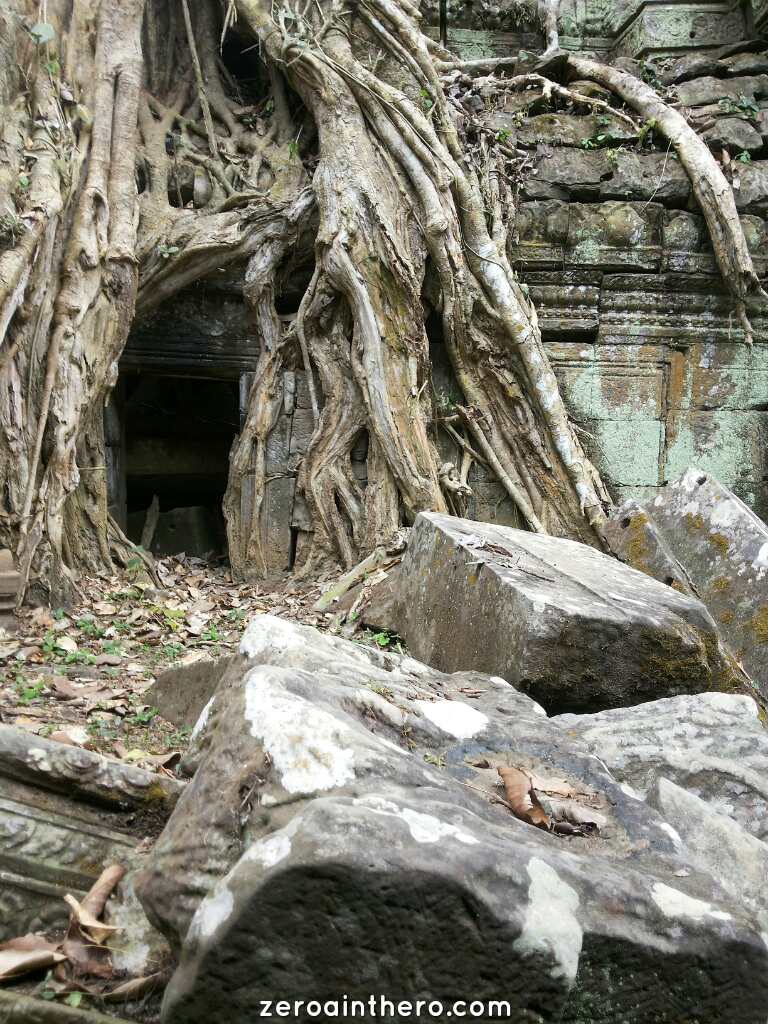
Apsaras seem to be the first ones to greet us upon entering our first temple – Ta Prohm. They serve as good introduction to Cambodian culture and history. In fact, they play a prominent part in the whole Angkorian culture and architectural theme of the day. Below are the apsaras stationed at the wall near the entrance.

“Apsara (in Hindu mythology) is a celestial nymph, typically the consort of a gandharva or heavenly musician. In the Cambodian culture, Khmer female figures that are dancing or are poised to dance are considered apsaras; female figures, depicted individually or in groups, who are standing still and facing forward in the manner of temple guardians or custodians are called devatas.” – Wikipedia
Here are some of the other areas inside the temple grounds. As expected, it’s teeming with tourists 🙂

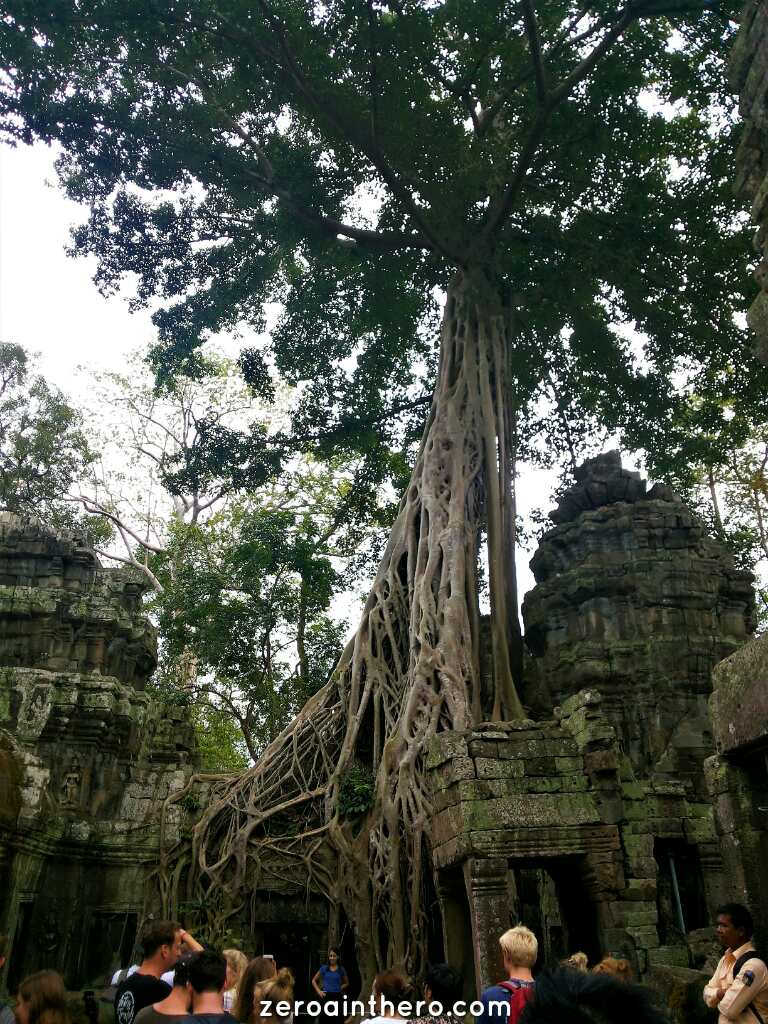



Next stop is the Bayon Temple, also known as Angkor Thom.

“Built in the late 12th or early 13th century as the state temple of the Mahayana Buddhist King Jayavarman VII, the Bayon stands at the centre of Jayavarman’s capital, Angkor Thom. Following Jayavarman’s death, it was modified and augmented by later Hindu and Theravada Buddhist kings in accordance with their own religious preferences” – Wikipedia
It goes on to say that the JSA, the main conservatory body in charge of the conservation and preservation of the site, describes the temple as “the most striking expression of the baroque style” of Khmer architecture, as contrasted with the classical style of Angkor Wat.
This is where I got lost for a time, having been separated from the group. Was having a hard time finding my pass and so the group went ahead without me. By the time I was allowed to get in, the group is nowhere to be found. So I just made my way to the top and explored Bayon by myself.
Been exploring corridors and galleries on the lower levels and got few surprises here and there. Turned a corner and found “treasures” like this.

Made my way the to the top and found gigantic statues (towers) of Avalokiteshvara faces, a bodhisattva. This is actually a Bayon temple signature. Hence, its other title – ‘the face temple‘.
Bodhisattvas are enlightened beings who are destined to become buddhas but postpone that final state in order to help humanity.





Another striking feature of Bayon is its adornment of 1.2 kms of extraordinary bas-reliefs incorporating more than 11,000 figures.


I wouldn’t be delving much into the details and stories behind these bas-reliefs but I highly suggest you search and read up on their background. It’s full of history and lots of interesting stories to tell. It’s like taking a peek into the soul of a proud kingdom – its glorious past, its people, its kings, its tales and legends; its everyday life; the mundane and the otherworldly; its idiosyncrasies and all.
Lonely Planet was on point when it said : “There is still much mystery associated with Bayon – such as its exact function and symbolism – and this seems only appropriate for a monument whose signature is an enigmatic smiling face”.
By this time, I was already able to catch up with the group.
Our final temple to visit is no other than the grandest and most majestic of them all – Angkor Wat. But before that, we first went to a restaurant outside the temple grounds as we all have been wanting to eat and take a break from all the walking and climbing, under a terribly hot weather.
Here are some of the food we devoured. I didn’t get the names of everything but some of them include: chicken with Khmer spice, deep-fried fish, fried egg, sauteed fried pork with eggplant, stir-fried veggies. I may not have gotten all the names correctly but you get the idea, right? No need to be all fussy about it 🙂
And so we entered the Angkor Wat temple grounds. ‘Massive’ is an understatement. We had to cross a body of water which seemed like some natural waterway, a river or something, but in reality is a gigantic man-made moat that surrounds the complex.

We noticed monkeys roaming around freely. There are those who seem to be welcoming us on the other end of the pontoon bridge, seated on stairwells and on railings.
Angkor Wat is “one of the largest religious monuments in the world, on a site measuring 162.6 hectares. It was built by the Khmer King Suryavarman II in the early 12th century in Yaśodharapura (present-day Angkor), the capital of the Khmer Empire, as his state temple and eventual mausoleum” – Wikipedia

Though damage is minimal, Angkor Wat has not been spared the effects of modern warfare. In fact, before entering, our guide showed us bullet holes left by a shoot-out between the Khmer Rouge and Vietnamese forces in the late ’70’s. This photo, in particular, shows bullet still left inside one of the walls of this ancient structure.

Even more destructive than the war itself though, were the rampant looting of the archaeological finds, by art thieves working out of Thailand. One could not help but notice the numerous headless statues and figures, as a consequence of this looting.
“Breaking from the Shaiva tradition of previous kings, Angkor Wat was instead dedicated to Vishnu. As the best-preserved temple at the site, it is the only one to have remained a significant religious centre since its foundation” – Wikipedia

Once again, monkeys roam careless and free 😀


Angkor Wat is at the top of the high classical style of Khmer architecture. It has become a symbol of Cambodia and is the country’s prime attraction for visitors.

Before entering the temple itself, we gathered in front of, what looked like a depression on the earth with a small lake-like structure at the bottom, to have our group and individual photos taken. This is a popular spot where people can take picture-perfect photos because of the reflection created by the water, for added drama.

Angkor Wat combines two basic plans of Khmer temple architecture: the temple-mountain and the later galleried temple. It is designed to represent Mount Meru, home of the devas in Hindu mythology.

The magnificence, the splendor, the scale of this ancient wonder. I was in awe.
The temple is admired for the grandeur and harmony of the architecture, its extensive bas-reliefs, and for the numerous devatas adorning its walls.

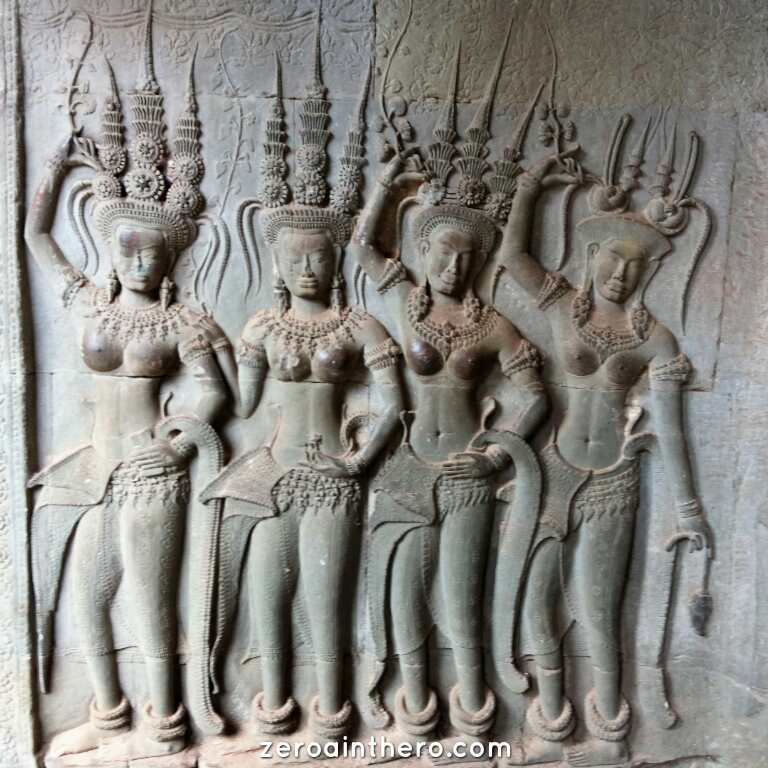


“The temple stands on a terrace raised higher than the city. It is made of three rectangular galleries rising to a central tower, each level higher than the last. Each gallery has a gopura at each of the points, and the two inner galleries each have towers at their corners, forming a quincunx with the central tower. Connecting the outer gallery to the second enclosure on the west side is a cruciform cloister called Preah Poan (the “Hall of a Thousand Gods”). The four small courtyards marked out by the cloister may originally have been filled with water. North and south of the cloister are libraries” – Wikipedia



“One of these temples, a rival to that of Solomon, and erected by some ancient Michelangelo, might take an honorable place beside our most beautiful buildings. It is grander than anything left to us by Greece or Rome…”
Henri Mouhot, 19th-century French naturalist and explorer

Yes, we romanticize how magnificent the structures are and how ingenious the engineering that was used to build them, but I don’t think people really understand the enormity and scale of this project even if I say it repeatedly and candidly. So, let’s put it in perspective, shall we?
The Khmer Empire ruled over a vast area of Southeast Asia, even larger than what modern Cambodia is today.


Its capital city is Angkor. At the time, before the advent of the Industrial Revolution, it was the world’s largest urban center. And in order to support such huge population, the Khmer built water management systems like huge reservoirs, canals, channels and dikes. They made good use of the resources that are available in season such as the monsoon. Water can be abundant in one season and scarce the next. This ingenious solution of efficiently utilizing a precious resource secured them a regular harvest.

For a long time, it has been a mystery how the society collapsed after about 200-300 years after its peak. There have been lots of theories, of course. Recently, however, a new one surfaced (and this is a real kicker). It states that environmental factors, otherwise known as ‘climate change‘ could have played a huge role in its demise. The ‘freaky’ weather patterns, like floods and droughts, overwhelmed those water management systems. And when I say freaky, I mean those that are not within the parameters of what is considered regular or normal. Basically, weather phenomenon that are off the charts.
We often hear about once in a 100-year type of flooding or drought, or heavy rainfall, right? They do happen as part of the natural cycles of the earth. What’s scary about our time though, is that our brand of climate change is self-inflicted. We create the causes for our own demise. And there’s no precedence of it anywhere in history. The CO2 levels and other pollutants we put in the air are staggering. Nowhere in recorded history has there been this much level of CO2 in the atmosphere. Scientists fear reaching a tipping point where we face the risk of a runaway weather, in which we wouldn’t have any control over nor could we predict with a much better certainty how the weather is going to behave.
Now who says history is not relevant to us today? We may have come a long way as a species but we surely have not learned from the errors of the past, or at least not have been as vigilant as we should have. The ancient ruins of Angkor are a poignant reminder of how even with the best technology and advancements, humans are no match to nature. We could very well suffer the same fate as the ancient Khmer people if we don’t change our ways.
So often we fail to value the natural world because of our greed. We treat it like a commodity, an unlimited resource. We need to realize that it is to our best interest to work with it and not against it.
Here’s to hoping things would work for the better. And soon.
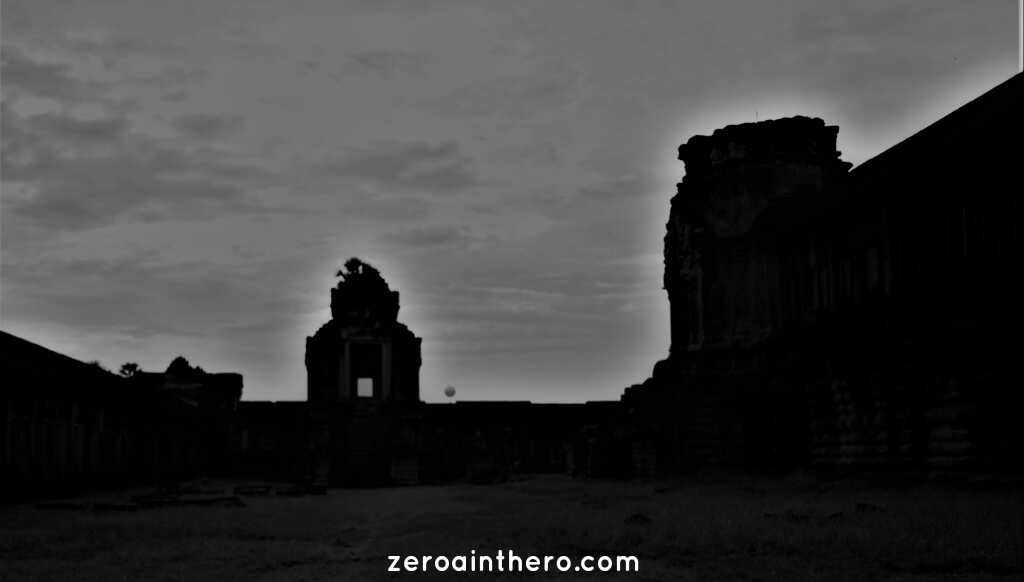
Special thanks to Real World Adventure for arranging our tour of the temples.
To Vox for this video, where screen grabs of the maps of Southeast Asia were taken.
Find them on Facebook:
@realwordadvanture
@Vox












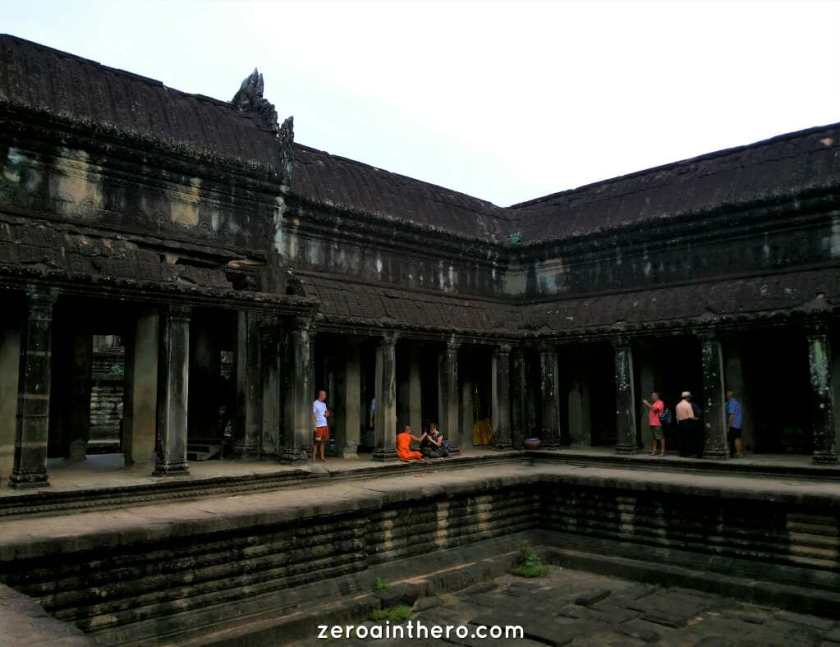

Thanks for posting this environmental message! I whole-heartedly agree with you, we need to pay more attention to history, not just our own but everyone’s, so we can avoid the mistakes they made. More power!
LikeLike
Thank you for your comment Dariel. It’s nice to know there are people like you who appreciate the work I’m trying to do here. Even in our own little way, we can do our part in spreading the message 🙂
LikeLike
The work on Angkor started in the year 800 as the new capital. Before that, it was located in Keulen. The blocks that were used to build the temple came all the way from the Keulen mountain. A visit to the Keulen waterfalls will provide an opportunity to see those blocks of stone in their natural environment. Nobody knows how those blocks were transported, some say by elephants. The new capital city was home to 700,000 people! The various kings built intricate water systems, apparently directing the water from Keulen mountains to Angkor. A lack of manpower and maintenance after a couple of extreme weather conditions led to people leaving the capital in search of better living conditions and the disintegration of the water systems. Finally, the ruling king of the time (around the 13th century) moved the capital once again, to Phnom Pen this time.
LikeLike